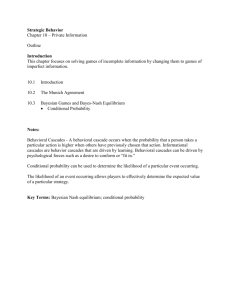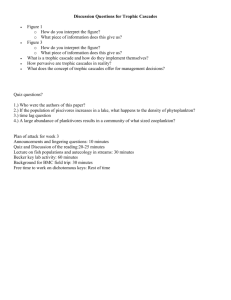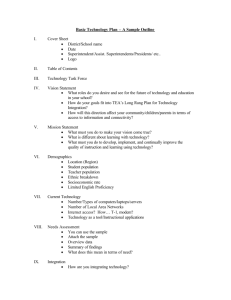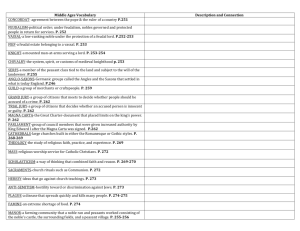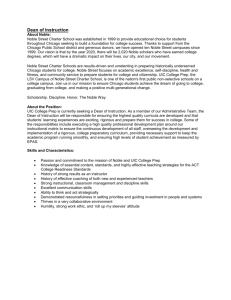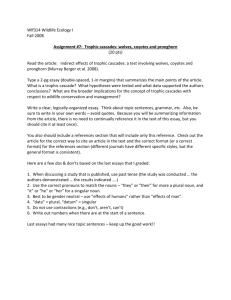Factors Impacting Implementation/non
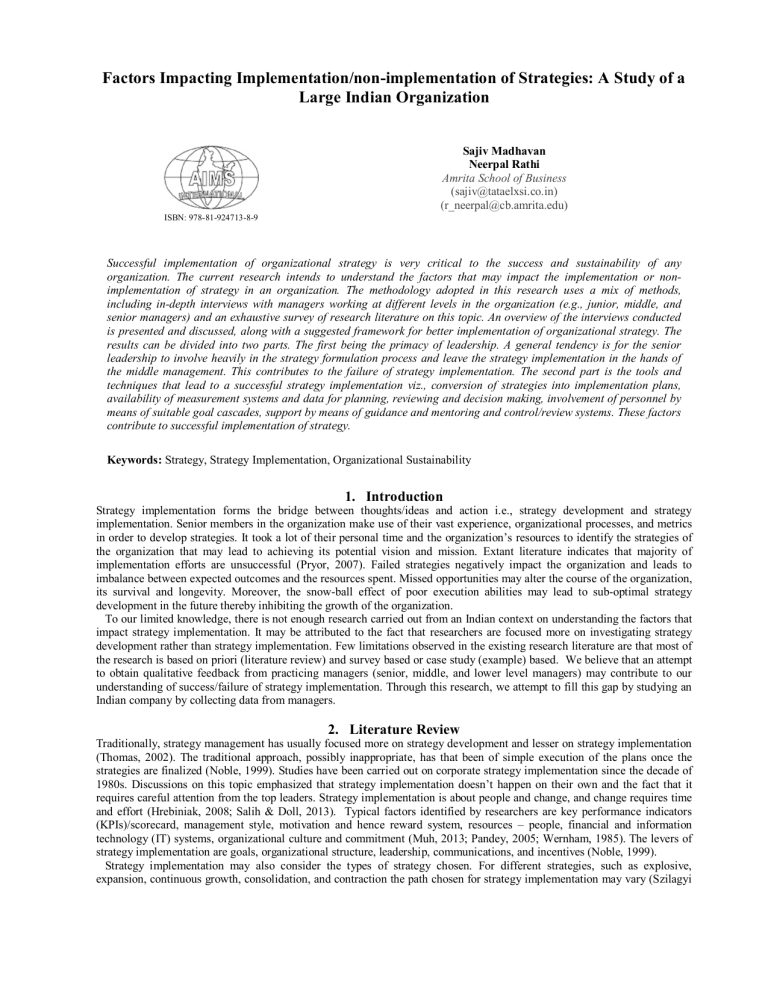
Factors Impacting Implementation/non-implementation of Strategies: A Study of a
Large Indian Organization
Sajiv Madhavan
Neerpal Rathi
Amrita School of Business
(sajiv@tataelxsi.co.in)
(r_neerpal@cb.amrita.edu)
ISBN: 978-81-924713-8-9
Successful implementation of organizational strategy is very critical to the success and sustainability of any organization. The current research intends to understand the factors that may impact the implementation or nonimplementation of strategy in an organization. The methodology adopted in this research uses a mix of methods, including in-depth interviews with managers working at different levels in the organization (e.g., junior, middle, and senior managers) and an exhaustive survey of research literature on this topic. An overview of the interviews conducted is presented and discussed, along with a suggested framework for better implementation of organizational strategy. The results can be divided into two parts. The first being the primacy of leadership. A general tendency is for the senior leadership to involve heavily in the strategy formulation process and leave the strategy implementation in the hands of the middle management. This contributes to the failure of strategy implementation. The second part is the tools and techniques that lead to a successful strategy implementation viz., conversion of strategies into implementation plans, availability of measurement systems and data for planning, reviewing and decision making, involvement of personnel by means of suitable goal cascades, support by means of guidance and mentoring and control/review systems. These factors contribute to successful implementation of strategy.
Keywords: Strategy, Strategy Implementation, Organizational Sustainability
1.
Introduction
Strategy implementation forms the bridge between thoughts/ideas and action i.e., strategy development and strategy implementation. Senior members in the organization make use of their vast experience, organizational processes, and metrics in order to develop strategies. It took a lot of their personal time and the organization’s resources to identify the strategies of the organization that may lead to achieving its potential vision and mission. Extant literature indicates that majority of implementation efforts are unsuccessful (Pryor, 2007). Failed strategies negatively impact the organization and leads to imbalance between expected outcomes and the resources spent. Missed opportunities may alter the course of the organization, its survival and longevity. Moreover, the snow-ball effect of poor execution abilities may lead to sub-optimal strategy development in the future thereby inhibiting the growth of the organization.
To our limited knowledge, there is not enough research carried out from an Indian context on understanding the factors that impact strategy implementation. It may be attributed to the fact that researchers are focused more on investigating strategy development rather than strategy implementation. Few limitations observed in the existing research literature are that most of the research is based on priori (literature review) and survey based or case study (example) based. We believe that an attempt to obtain qualitative feedback from practicing managers (senior, middle, and lower level managers) may contribute to our understanding of success/failure of strategy implementation. Through this research, we attempt to fill this gap by studying an
Indian company by collecting data from managers.
2.
Literature Review
Traditionally, strategy management has usually focused more on strategy development and lesser on strategy implementation
(Thomas, 2002). The traditional approach, possibly inappropriate, has that been of simple execution of the plans once the strategies are finalized (Noble, 1999). Studies have been carried out on corporate strategy implementation since the decade of
1980s. Discussions on this topic emphasized that strategy implementation doesn’t happen on their own and the fact that it requires careful attention from the top leaders. Strategy implementation is about people and change, and change requires time and effort (Hrebiniak, 2008; Salih & Doll, 2013). Typical factors identified by researchers are key performance indicators
(KPIs)/scorecard, management style, motivation and hence reward system, resources – people, financial and information technology (IT) systems, organizational culture and commitment (Muh, 2013; Pandey, 2005; Wernham, 1985). The levers of strategy implementation are goals, organizational structure, leadership, communications, and incentives (Noble, 1999).
Strategy implementation may also consider the types of strategy chosen. For different strategies, such as explosive, expansion, continuous growth, consolidation, and contraction the path chosen for strategy implementation may vary (Szilagyi
2302 Twelfth AIMS International Conference on Management
& Schweiger, 1984). Several researchers have investigated various aspects of strategy implementation. However, not much research has been carried out in the Indian context to understand various factors that may influence strategy implementation.
Through this study, we wish to identify the vital factors that practitioners can make use of for implementing strategies.
3.
Role of Top Management
The senior leadership involves itself heavily during the strategy development process. This is critical as the organization reviews their strategic challenges and strategic advantages and takes an informed choice of the path to pursue, after considering internal and external factors (Hrebiniak, 2005). Strategies thus chosen are pursued for implementation and typically action plans and tasks are drawn up to accomplish these. The phase moves from strategy development to strategy implementation. The most important factor for successful implementation of any strategy is the ownership and accountability of the senior management on the strategy chosen and in realizing the action plans/tasks (Kuyvenhoven & Buss 2011; Rose &
Cray 2013).By this, they show their peers and team members the importance of the job that they have embarked upon. Their involvement provides the impetus for the stakeholders involved in committing themselves for the success of the strategies.
The validation of the strategies takes place in a definite manner (Rose & Cray, 2013; Schaap, 2006), as the ownership and accountability gets attached to the senior leadership. Self-doubts by the stakeholders on how good/difficult are the paths chosen get negated by the involvement of senior leadership. They assume that the strategies are validated, lest the senior leadership will not commit itself to this trial by fire. Strategy implementation involves transformation and this warrants changes to the routines adopted till then. It is extra hard because of the changes in status-quo and senior leadership plays an important role in shifting the current rhythm/practices. The senior leadership, by the very fact, of their position and power will be able to provide the necessary organizational structure, processes and people for a successful strategy implementation
(Higgins, 2005). The senior leadership is in a position to change direction and alter the course of the initiatives, if a need arises.
The organizational structure relates to functional teams and their reporting relationships. These teams may be from cross functional teams or project groups formed to accomplish the tasks. The team members are likely to have multi-responsibilities i.e., operational and strategic and hence the leadership will be able to counsel them on the priorities and the amount of balance
(Noble, 1999). Based on the need, external consultants may be brought in to augment the skill sets. The involvement of senior leadership at this stage is key to the way the implementation teams are structured.
The processes relates to enablement of work flow with minimal bottlenecks (Higgins, 2005). This can call for periodic status meetings, task instructions, easing of dependencies, automation, if any. As teams are formed for typically shorter periods, the expectation at every stage needs to be established for the tasks to be accomplished at the appropriate pace, effort with the right quality. People factor relates to the availability of capable people for accomplishing the tasks that arise for successful implementation of the strategies (Hrebiniak, 2008). General tendency is to fit the person into the task/role asked for, while implementing the strategies. An analysis of the skill sets required to drive the strategy implementation and then the right people being brought in to accomplish them, though important, is seldom done. This causes a lot of slack in the execution and many a times, issues on the team dynamics (Kuyvenhoven & Buss, 2011). Typically, people are drawn from multiple groups/units based on the skill requirement to accomplish the task. It is important to maintain alignment between these groups/units.
Strategies need to be communicated to the respective groups in order to create the awareness and seek each group’s cooperation and collaboration (Wernham, 1985). This is especially true in accomplishing initiatives that seek people from multiple groups and divisions. With constant reinforcement of the strategies the likelihood of staying on-course to accomplish the strategies are high. The importance of communication needs to be overemphasized. Past literature and our interviews highlighted this as an important facet for success in strategy implementation (Kuyvenhoven & Buss, 2011; Noble, 1999;
Rose & Cray, 2013; Salih & Doll, 2013). Rewards and recognitions form an essential part of the motivation for teams to stay on course. As most of the tasks relate to non-routine work, they tend to be more difficult. Schemes of incentives and other means of rewards and recognitions provide the impetus to go the extra mile to accomplish the tasks(Hrebiniak, 2008; Noble, 1999) .
The factors (categorized as drivers and enablers) are figuratively shown below:
Enable Drivers
Senior Leadership
Organisation
Process
People
Communication
Rewards & Recognition
Implementation Plans
Measurement Systems
Goal Cascades
Guidance and Mentoring
Control/Review Systems
Strategy Implementation
Figure A
Twelfth AIMS International Conference on Management 2303
4.
Tools and Techniques
The tools and techniques are enablers for successful strategy implementation. These provide the environment for organizations to implement their strategies. Needless to say, their absence seriously handicaps the organization from successfully implementing their strategies.
Conversion of Strategies into Implementation Plans : Strategies remain as a wish list if they stay where they are, as in presentations and on worksheets. The success of the strategy plan execution lies in the making of implementation plans.
Depending on the complexity and time horizons these implementation plans have to be detailed, modular, and telescopic.
These implementation plans remain a vital linkage to all other parts discussed in this part e.g., measurement systems, alignment between groups/units, and can also assist in precise communication. Implementation plans also establishes the start/stop criteria and stages at which the strategies move to an operational phase.
Measurement Systems and Data Availability for Planning, Reviewing, and Decision Making : One of the least remarked, yet most vital part of a successful implementation, is the availability of measurement systems and data. Without this, many strategy plans had met with failure as the teams and their sponsors were not able to make the right judgment on the course of implementation and their pace. By the time they face the reality that not much improvement has taken place in the chosen direction, precious time is lost and the cause mostly abandoned because of the effort overrun and resource depletion.
Involvement of Personnel by Means of Suitable Goal Cascades : Goal setting elicits a sense of shared ownership from the concerned groups/personnel. It also communicates the part played by each team member and the expected outcomes. This comes in handy for cascades to different levels of the organization in accomplishing the strategies. In normal practice, it is not that everybody in the organization gets to know the big picture i.e., the strategies. In such cases, goal cascades help in reaching to even team members whose part/tasks may be in the periphery. They know that by accomplishing their goals, they contribute to the overall success of the strategies. The goal cascades also bring alignment between the various groups and team members involved.
Support by Means of Guidance and Mentoring : Interviews conducted by us provided insights that the team members involved require a lot of guidance and mentoring. They look for hand-holding for them to succeed. They look up to the organization to support them in resolving the ambiguities that may arise out of the non-routine tasks that arise due to the very nature of the transformation needs of the strategies. Appropriate support apparatus helps the teams that are involved in working towards the success of the strategies.
Control/Review Systems : By establishing check points and evaluation criteria, the progress of the strategies can be monitored. The periodicity of these systems needs to be established. Reviews can bring out the task/schedule adherence and reinforcements required to stay on-course. Bigger the strategies, random audits may be undertaken to ascertain the gaps. Due to the atypical nature of the strategies, it is imperative for leaders and team members to identify these and follow-through during the lifecycle of the strategy implementation. Expert/peer reviews also help in enhancing the cause of success implementation of strategies.
5.
Conclusion
The purpose of this study was to understand various factors that may contribute to implementation/non-implementation of organizational strategy. This study was carried out in a large Indian organization. Findings of this research are based on interviews of managers working at different levels. The factors identified revealed that the role of senior leadership is very critical for strategy implementation. This is especially true in growing economies, such as India with a large pool of younger team members getting into the workforce. Top management need to approve the initiative so that it carries forward in the desired direction. Involvement of top management in setting up the structure, formulating the processes, getting the people, communicating the strategies and rewarding the teams/individuals is very critical for successful implementation of organizational strategy.
6.
References
1.
Akbar A. S., Salamzadeh, Y., Daraei, M., &Akbari, J. (2012). Relationship between organizational culture and strategy implementation: Typologies and dimensions. Global Business & Management Research, 4(3/4), 286-299.
2.
Bourgeois III, L. J., & Brodwin, D. R. (1984). Strategic implementation: Five approaches to an elusive phenomenon.
Strategic Management Journal, 5(3), 241-264.
3.
Hahn, W., & Powers, T. L. (2010). Strategic plan quality, implementation capability, and firm performance. Academy of
Strategic Management Journal, 9(1), 63-81.
4.
Higgins, J. M. (2005). The eight ‘S’s of successful strategy execution. Journal of Change Management, 5(1), 3-13.
5.
Hrebiniak, L. (2008). Making strategy work: overcoming the obstacles to effective execution. Ivey Business Journal,
72(2), 1-6.
6.
Kuyvenhoven, R., & Buss, C. W. (2011). A normative view of the role of middle management in the implementation of
2304 Twelfth AIMS International Conference on Management strategic change. Journal of Management & Marketing Research, 81-14.
7.
Muh. Darmin Ahmad, P., Ujang, S., Arief, D., &Kirbrandoko. (2013). Factors affecting poor strategy implementation.
GadjahMada International Journal of Business, 15(2), 183-204.
8.
Noble, C. H. (1999). Building the strategy implementation network. Business Horizons, 42(6), 19.
9.
Pandey, I. M. (2005). Balanced Scorecard: Myth and Reality. Vikalpa: The Journal for Decision Makers, 30(1), 51-66.
10.
Pryor, M., Anderson, D., Toombs, L. A., & Humphreys, J. H. (2007). Strategic implementation as a core competency.
Journal of Management Research, 7(1), 3-17.
11.
Rose, W. R., & Cray, D. (2013). The role of context in the transformation of planned strategy into implemented strategy.
International Journal of Business Management & Economic Research, 4(3), 721-737.
12.
Salih, A., & Doll, Y. (2013). A middle management perspective on strategy implementation. International Journal of
Business and Management, 8(22), 32-39.
13.
Schaap, J. I. (2006). Toward strategy implementation success: An empirical study of the role of senior-level leaders in the Nevada gaming industry. UNLV Gaming Research & Review Journal, 10(2), 13-37.
14.
Smith, B. D. (2009). Maybe I will, maybe I won't: What the connected perspectives of motivation theory and organisational commitment may contribute to our understanding of strategy implementation. Journal of Strategic
Marketing, 17(6), 473-485.
15.
Szilagyi, A. D., Jr., & Schweiger, D. M. (1984). Matching managers to strategies: A review and suggested framework.
Academy Of Management Review, 9(4), 626-637.
16.
Wernham, R. (1985). Obstacles to strategy implementation in a nationalized industry. Journal of Management Studies,
22(6), 632-648.
